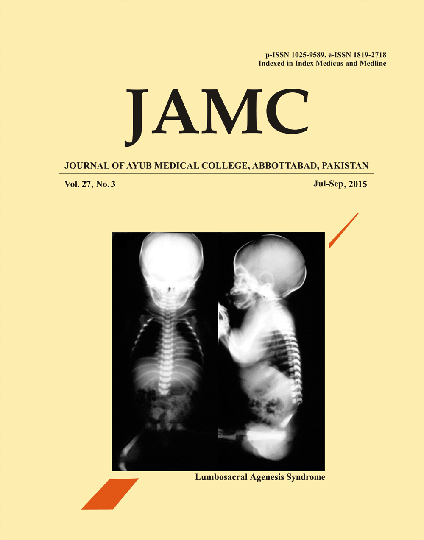OUTCOME OF OPEN CARPAL TUNNEL RELEASE SURGERY
Abstract
Background: Carpel tunnel syndrome is a common compression neuropathy of the median nerve causing pain, numbness and functional dysfunction of the hand. Among the available treatments, surgical release of the nerve is the most effective and acceptable treatment option. The aim of this study was to see the outcomes of surgical release of carpel tunnel using open technique. Methods: This descriptive case series was conducted at the Department of neurosurgery, Ayub Teaching Hospital Abbottabad from April 2013 to March 2014. One hundred consecutive patients with carpel tunnel syndrome were included who underwent open carpel tunnel release surgery. They were followed up at 1, 3 and 6 months. Residual pain, numbness and functional improvement of the hand were the main outcome measures. Results: Out of 100 patients, 19 were males. The age ranged from 32 to 50 years with a mean of 39.29±3.99 years. The duration of symptoms was from 5 to 24 months. In the entire series patient functional outcome and satisfaction was 82% at 1 month, 94% at 3 months and 97% at 6 months. 18% patient had residual pain at 1 month post-operative follow-up, 6% at 3 months and 3% at 6 month follow-up. Conclusion: Open carpel tunnel release surgery is an effective procedure for compression neuropathy of the median nerve. It should be offered to all patients with moderate to severe pain and functional disability related to carpel tunnel syndrome.References
Ibrahim I, Khan WS, Goddard N, Smitham P. Carpal tunnel syndrome: a review of the recent literature. Open Orthop J 2012;6:69–76.
Alfonso C, Jann S, Massa R, Torreggiani A. Diagnosis, treatment and follow-up of the carpal tunnel syndrome: a review. Neurolog Sci 2010;31:243–52.
Padua L, LoMonaco M, Padua R. Neurophysiological classification of carpal tunnel syndrome: assessment of 600 symptomatic hands. Ital J Neurol Sci 1997;18:145–50.
Kuhlman KA. Sensitivity and specificity of carpal tunnel syndrome sign. Am J Phys Med Rehabil 1997;76:451–7.
Amirfeyz R, Gozzard C, Leslie IJ. Hand elevation test for assessment of carpal tunnel syndrome. J Hand Surg Br 2005;30:361–4.
ElMiedany Y, Ashour S, Youssef S. Clinical diagnosis of carpal tunnel syndrome: old tests-new concepts. Joint Bone Spine 2008;75:451–7.
O'Connor D, Marshall S, Massy-Westropp N. Non-surgical treatment (other than steroid injection) for carpal tunnel syndrome. Cochrane Database Syst Rev 2003;(1):CD003219.
Turner A, Kimble F, Gulyas K, Ball J. Can the outcome of open carpal tunnel release be predicted?: a review of the literature. ANZ J Surg 2010;80:50–4.
Aroori S, Spence RA. Carpal tunnel syndrome. Ulster Med J 2008;77:6–17.
Uchiyama S, Itsubo T, Nakamura K, Kato H, Yasutomi T, Momose T. Current concepts of carpal tunnel syndrome: pathophysiology, treatment, and evaluation. J Orthop Sci 2010;15:1–13.
de Krom MC, Knipschild PG, Kester AD, Thijs CT, Boekkooi PF, Spaans F: Carpal tunnel syndrome: prevalence in the general population. J Clin Epidemiol 1992;45:373–6.
Saboor A, Khan A, Afridi SA, Khan IU, Bhatti SN, Ahmed E, Muhammad G, et al. Early response of local steroid injection versus mini incision technique in treatment of carpal tunnel syndrome. J Ayub Med Coll Abbottabad 2015;27(1):192–6
Rask MR. Anterior interosseous nerve entrapment: (Kiloh-Nevin syndrome) report of seven cases. Clin Orthop Relat Res1979;142:176–81.
Phalen GS. The carpal-tunnel syndrome. J Bone and Joint Surg Am 1966; 48: 380-3.
Georgiew F, Maciejczak A, Florek J. Results of surgical treatment of carpal tunnel syndrome. Ortop Traumatol Rehabil. 2014;16:455-68.
Haupt WF, Wintzer G, Schop A, Löttgen J, Pawlik G. Long-term results of carpal tunnel decompression. Assessment of 60 cases. J Hand Surg Br.1993;18:471-4.
Katz JN, Fossel KK, Simmons BP, Swartz RA, Fossel AH, Koris MJ. Symptoms, functional status, and neuromuscular impairment following carpal tunnel release. J Hand Surg Am 1995;20:549–55.
Nancollas MP, Peimer CA, Wheeler DR, Sherwin FS. Long-term results of carpal tunnel release. J Hand Surg Br 1995;20:470–74.
Dahlin LB, Salo M, Thomsen N, Stütz N. Carpal tunnel syndrome and treatment of recurrent symptoms. Scand J Plast Reconstr Surg Hand Surg. 2010;44:4–11.
Published
Issue
Section
License
Journal of Ayub Medical College, Abbottabad is an OPEN ACCESS JOURNAL which means that all content is FREELY available without charge to all users whether registered with the journal or not. The work published by J Ayub Med Coll Abbottabad is licensed and distributed under the creative commons License CC BY ND Attribution-NoDerivs. Material printed in this journal is OPEN to access, and are FREE for use in academic and research work with proper citation. J Ayub Med Coll Abbottabad accepts only original material for publication with the understanding that except for abstracts, no part of the data has been published or will be submitted for publication elsewhere before appearing in J Ayub Med Coll Abbottabad. The Editorial Board of J Ayub Med Coll Abbottabad makes every effort to ensure the accuracy and authenticity of material printed in J Ayub Med Coll Abbottabad. However, conclusions and statements expressed are views of the authors and do not reflect the opinion/policy of J Ayub Med Coll Abbottabad or the Editorial Board.
USERS are allowed to read, download, copy, distribute, print, search, or link to the full texts of the articles, or use them for any other lawful purpose, without asking prior permission from the publisher or the author. This is in accordance with the BOAI definition of open access.
AUTHORS retain the rights of free downloading/unlimited e-print of full text and sharing/disseminating the article without any restriction, by any means including twitter, scholarly collaboration networks such as ResearchGate, Academia.eu, and social media sites such as Twitter, LinkedIn, Google Scholar and any other professional or academic networking site.









